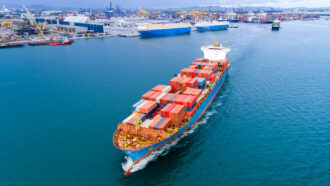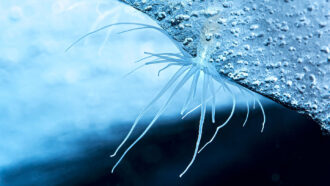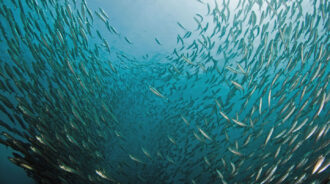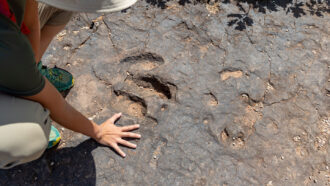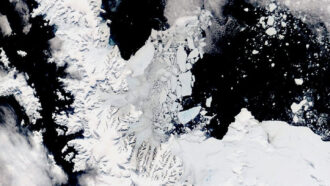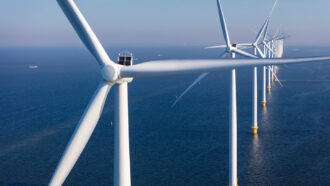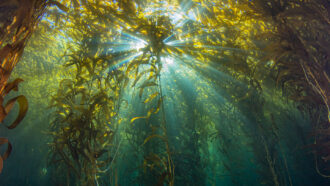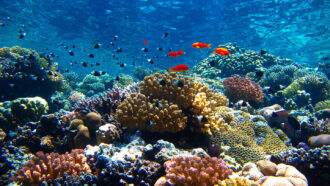Beaches can be a germy playground
Some playgrounds for vacationers are also hotspots of disease-causing microbes
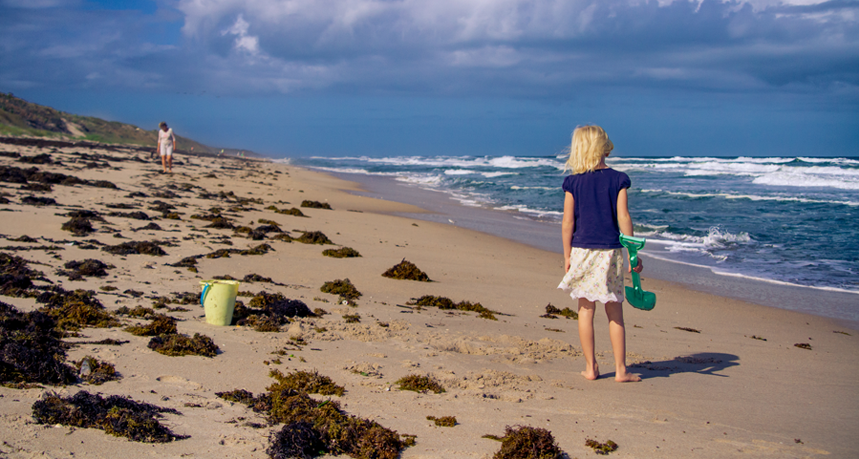
Caption: This beach vista looks clean and inviting. But it may be hiding dense communities of fecal germs, so always wash up well after playing in the sand and surf.
Rain0975/Flickr (CC BY-ND 2.0)
Grab a handful of sand on your next visit to the beach. Feel the jagged edges of grains and the sticky moisture they leave behind on your skin. Countless unseen microbes — bacteria and algae — live in that sand.
Yet the beach is a tough place to call home, even for plants, animals, bacteria and other organisms that evolved to live there. The microbes that live in beach sand must endure pounding surf, harsh sunlight, changing tides, howling winds, violent storms and large swings in temperature and moisture — sometimes even freezing winters. It’s not any easy life for many.
“The wind and sand blowing across those places are like sand blasters,” notes Richard Whitman. He works at Valparaiso University in Indiana. As an aquatic biologist, he is an expert on organisms that live in the water. Many microbes can’t take such tough conditions.
But others have evolved a knack for hiding. Some may tuck into crevices that crisscross the surface of sand grains. Others make homes in miniature creeks that flow among the grains. Still others cling to sand grains’ firm surfaces. A sturdy surface that microbes can grow on is known as a substrate. It can be anything from a grain of sand or a ship’s hull to a concrete piling.
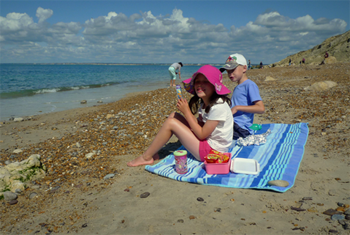
When bacteria and algae find a welcoming substrate, they begin creating what amounts to a microscopic city. To secure their borders, the inhabitants build a moist cover. It’s a thin layer of slime, also known as a biofilm. Some germ-guarding biofilms can survive for weeks — even months.
Many biofilm residents in beach sand are harmless. Others, known as pathogens, can cause infectious disease. Accidentally swallow some of them and you might develop diarrhea. Digging in germy sand raises the risk of stomach disease, especially in children. Some pathogens can lead to eye and ear infections. Break up some sand communities and pathogens may become airborne. Breathing these in could trigger lung infections, making it hard to breathe.
Health concerns about touching beach sand are driving many scientists to scout for where pathogens lurk — and where they originally came from. Other scientists are studying whether features of beaches, such as the height or force of waves, affect where on a beach those pathogens will build their homes.
How germs get beached
Beaches are home to wildlife — from crabs or frogs to insects and birds. No surprise, these creatures can supply some germs. As gulls walk along the sand to scavenge a meal or fly overhead, they will periodically shed poop. Their feces will have germs. Plants that wash onto beaches can provide a welcoming home to microbes involved in the greenery’s decay.
Rain washes cow and pig poop, or manure, off of farmlands. Pet and wildlife waste runs off of lawns and streets. All of these germ-ridden wastes will eventually flow downstream into lakes, rivers and oceans.
But the most numerous pathogens on beaches come from people. The human gut teems with germs. Some are harmless and others are pathogens. As with other animals, people excrete some of those gut microbes out in their poop.
Once flushed down the toilet, these wastes — known as sewage — travel through pipes for disposal. Researchers have found more than 100 different pathogens in sewage. Some of them can show up in very high concentrations.
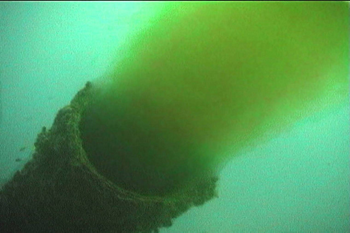
Homes typically pipe that sewage to septic tanks or a town’s waste-treatment plant. Septic tanks are containers below ground that filter and capture many pathogens. Sewage treatment plants are facilities that treat waste to kill or filter out pathogens from the water passing through them. But septic tanks can leak into groundwater. From there, germs can seep into downstream rivers, lakes or the ocean. Worse still, some communities send sewage directly into waterways without treating it.
Joan Rose works at Michigan State University in Lansing. As a public health microbiologist, she studies pathogens in water. “We’re finding more all of the time,” says Rose. The microbes often get carried down streams to sea coasts where waves, currents and tides later deposit them on beaches.
The main sources of pollution will differ from one beach to another. To home in on the source of pathogens residing at the beaches they study, Rose and her team collect coastal water, beach sand and soils. Then they scout for any bacterial DNA in their samples and map the types. In this way, they look for a “signature” of the upstream sources of those germs.
Crime scene investigators on TV shows often do DNA analyses to identify the suspects, Rose says. “We can do the same thing for bacterial DNA.”
Her team is tracking bacteria from feces in 64 rivers that flow into Lake Michigan and Lake Huron. Those are two of the Great Lakes. Along some shorelines, seagulls shed most of these feces, they find. In other coastal areas, the main problem is runoff of farm manure or poor treatment of human sewage. And in still others, they’ve traced most of the germs to leaking septic tanks.
Testing the waters — and the sand
By law, state health agencies must monitor the water at along beaches where people swim for the types of bacteria commonly found in the feces of people and other mammals. Throughout summer, the water is sampled at least once every two weeks.
Most of these fecal bacteria won’t harm people. They simply don’t cause human disease. But when water contains a lot of these germs, it serves as a warning that pathogens, too, could be lurking there. For this reason, the largely harmless fecal bacteria are called bioindicators. This means they point to a possible hidden health threat. When state agencies find high concentrations of bioindicator germs in the water at a beach, they warn people not to swim there.
Pathogens excreted in human feces tend to be the most dangerous. So Rose argues that beaches where human fecal bacteria are most common should be the top priorities for follow-up monitoring and cleanup.
In a recent study of the rivers Rose and colleagues have been monitoring, the researchers found a sign of leaking septic tanks. Their evidence: Water samples in areas with more than 1,621 septic tanks had far higher levels of bacteria associated with human feces than did areas with few septic tanks.
“We can’t fix everything at one time,” says Rose. “We need to spend wisely to protect waterways and beaches.” So the types of information that her team uncovered in Michigan might help communities decide which areas — and pollution sources — to clean up first.
Rose’s team published its findings in August 2015 in the Proceedings of the National Academy of Sciences.
Monitoring water along beaches is important. But water in an ocean, lake or river can naturally dilute pollutants within hours — and even more quickly if there are strong currents or high waves. Germs in sand can survive far longer. By testing water only, health agencies risk missing high levels of fecal microbes lurking in beach sand.
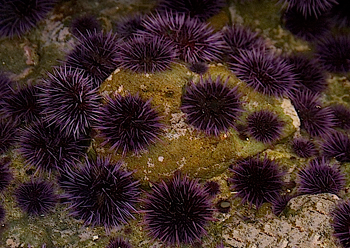
Some studies have shown that a sample of beach sand can contain 10 to 100 times more fecal bacteria (measured as colony units per gram) than a sample of water (measured as colony units per milliliter). That means the sand probably also contains more harmful germs than the water does, according to Helena Solo-Gabriele. She works at the University of Miami in Florida. As an environmental engineer, she studies how contaminants move through the environment and affect human health.
Monitoring beach sand — as well as water — might also help scientists better understand where pathogens flourish, says Solo-Gabriele
But testing sand isn’t nearly as easy as sampling water. To sample 100 gallons of water, someone scoops out that much water and tests it for bioindicator microbes. Water moves and mixes easily up, down and all around. So one water sample may be as representative as another 50 yards (about 45 meters) away.
But the germs glommed onto sand bits within a slimy biofilm don’t move — much less mix — as readily. That poses a problem for researchers. They won’t know which parts of the beach may be most tainted. And that can make it hard to know where to go out and measure. Many beaches change by the hour as tides slosh in and go out. And as waves pound, they may remove the surface layer of a beach, exposing deeper sand. So a beach might be cleaner in the early morning than after people have spent the day there.
When it comes to sand, Rose says, “We still have a lot of detective work to do. How much sand should be collected? Where should we collect it? How deep should we scoop? Should we do sampling first thing in the morning? How much do tides affect the quality of the sand?” The answers, she points out, could be vitally important.
Microbes’ sandy hiding places
Understanding how — and where exactly — germs manage to survive and thrive on beaches is just as crucial as understanding where they come from in the first place.
Microbes feast on seaweed, marsh reeds and algae that get stranded on beaches. This debris is called wrack. It provides nutrients, shade, moisture and wind protection for germs. Tides push it up the beach as they rise higher and higher. So wrack tends to accumulate at the high-tide line on a beach.
For weeks, high tides can repeatedly moisten the wrack without cleansing the sand of microbes. “We find hotspots of these fecal organisms right at the upper edge of the high-tide line, where seaweed accumulates” on beaches, says Solo-Gabriele.
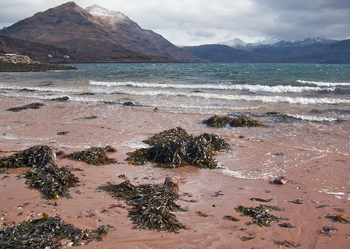
During extreme high tides, stranded wrack, fecal bacteria and sand may again wash down the beach toward the water. It comes to rest in an area called the intertidal zone. This area, where children often play, is dry during low tide but covered in water at high tide. Eventually, tides may wash bacteria and other microbes from the intertidal beach sand out into shallow coastal water. This risks exposing waders and swimmers to germs. That process happens repeatedly.
Solo-Gabriele and colleagues recently reviewed research examining where germs collect in beach sand. They also pored over data on how those germs can move back and forth between the beach and the water. The team published its review in the February issue of the Journal of the Marine Biological Association of the United Kingdom.
“We see a lot of low fecal bacterial counts in the water, and then suddenly we see a high spike,” says Solo-Gabriele. “Then we see more low counts for a while, and another spike.” She thinks those spikes may come from germs that build up in wrack at the high-tide line and then move into the water as the tide recedes. If health officials don’t happen to be monitoring the water when pathogens are spiking, they might miss the period of higher risk.
The structural characteristics of beaches also can affect exposure to fecal germs. Bacteria tend to concentrate for fairly long periods in calm waters. Where the water turns choppy, waves tend to dilute and spread bacteria. That dilution can lower the risk of infection to swimmers by exposing them to lower levels of germs.
Solo-Gabriele and colleagues recently examined water quality at 262 of Florida’s coastal beaches along the Atlantic Ocean and Gulf of Mexico. The Gulf has 76 low-wave beaches, accounting for almost half of the beaches there. The Atlantic has only 10 low-wave beaches but 96 beaches with high waves.
As Solo-Gabriele and colleagues predicted, water at Gulf beaches tended to have more frequent spikes of high bacteria. For instance, 10 Gulf beaches had high bacterial counts more than 9 out of every 100 days. Meanwhile, no Atlantic coast beaches did. The team published its findings in the March Marine Pollution Bulletin.
A handful of sand at the beach can be a hothouse for harmful germs. As scientists learn more about where these microbes come from and where they thrive, the next step is to develop new and inexpensive tools to accurately monitor beach sand. This will allow communities to create more timely and accurate warnings to protect the public health.
